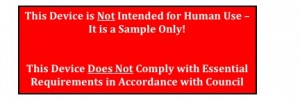Article 4 of Council Directive 93/42/EEC, a.k.a., the Medical Device Directive (MDD) establishes the requirements for “free movement, devices intended for special purposes.” Basically, Article 4 states you can move all medical devices into the European Union (EU) “free of charge, shipping is per gratis” – just kidding, but I hope Dr. D has caught your attention.
All joking aside, there is some truth in the last sentence, and no, it is not the free shipping. According to Article 4, if a medical device has been assessed (by a notified body) for conformity with essential requirements and has a legally affixed CE mark, member states cannot block the shipment of devices intended for special purposes or clinical investigational use, into the EU. In fact, Article 4 is prescriptive with pointers to Article 17 (CE marking) and Article 11 (conformity assessment procedures). In this week’s edition of Devine Guidance (DG), the doctor will provide some insight needed for complying with Article 4 of the MDD.
Before I dive into Article 4 of the Directive, I want to reinforce a point, previously made, in regards to employing harmonized standards. I was having dinner with a good friend of mine last week in Boston (yes – Dr. D does have friends); and he recommended that I reinforce the point that these standards are recommended. That being said, Dr D will reiterate, “Harmonized standards are recommended.” However, it is a daunting if not nearly impossible task to have a quality system approved or device approved without complying with a few of the more “popular standards,” such as EN ISO 13485, EN ISO 14971, or EN 980.
- devices intended for clinical investigation being made available to medical practitioners or authorized persons for that purpose if theymeet the conditions laid down in Article 15 and in Annex VIII,
- custom-made devices being placed on the market and put intoservice if they meet the conditions laid down in Article 11 in combination with Annex VIII; Class IIa, IIb and III devices shall be accompanied by the statement referred to in Annex VIII, which shall be available to the particular patient identified byname, an acronym or a numerical code.
These devices shall not bear the CE marking.
What you need to know
For starters, devices intended for use in clinical investigations or custom-made devices will be allowed entry into the EU if the requirements of Article 4 are met. Pretty simple right? Remember, qualifying devices for initial entry into the EU can sometimes be categorized as a quixotic (look-it up) pursuit, due to the unpredictability of some notified bodies and their interpretation of the Directive. Confucius says, “It is always better to pursue a cautionary approach and work toward full compliance with the MDD.” As Dr. D stated in the opening paragraph, member states cannot block entry of devices into the EU for use, providing these devices meet their stated essential requirements and have CE marks affixed.
There is an exception to the CE mark rule. Article 4 does permit the entry of devices not complying with the Directive providing such devices are properly identified as not being in compliance with the MDD. Additionally, devices in this category should never have a CE mark affixed. An example of devices falling into this category would be demonstration units being used for a tradeshow. God forbid – the world of pain competent authorities are capable of unleashing should devices in this category find their way into the hands of clinicians for actual patient use.
Another important requirement of Article 4 is that device manufacturers need to comply with the native-language requirement. The ongoing addition of country-specific labeling requirements continues to pose significant challenges for device manufacturers. According to Article 4 of the Directive, each member state has the legal right to have device labeling and the Directions for Use (DFU) in their native language. Can you say stop killing trees? The doctor has personally seen DFUs turn into books as device manufacturers attempt to meet this Article 4 requirement. In fact, the device labeling requirements pose significant challenges due to the lack of available real estate on the labels.
A few weeks ago, Dr. D mentioned that in some cases devices might be “subject to other Directives.” According to Article 4 of the MDD, the concept of compliance with multiple Directives is acceptable; however, when such scenarios occur, the device manufacturer must clearly document the Directives that are applicable and provide the relevant compliance information to their notified body. Once again, your notified body can assist with providing direction for complying with the MDD. In the case of Article 4, the requirement is very specific; “Where the devices are subject to other Directives concerning otheraspects and which also provide for the affixing of the CE marking, the latter shall indicate that the devices also fulfill the provisions of the other Directives.”
What you need to do
It is Dr. D’s personal opinion, there are a modicum of qualified notified bodies that can help device manufacturers navigate the regulatory waters of the EU (TUV-R & BSI are excellent examples – again not a paid spokesperson). Select and partner with a recognized and qualified notified body; and entering devices into the European market may not be the proverbial “cake walk,” but the process will be considerably more palatable. That being said, here is what you need to know.
- Remember to test, validate, qualify, etc. devices that are going to be entering into the EU for clinical investigations. This includes custom-made devices. The only way to accomplish this task is by obtaining formal device approval through your notified body, once essential requirements have been fulfilled. Once approved, you can affix the CE mark containing your notified bodies’ registration number; and commence with the shipments into the EU, after the applicable certificates have been received.
- Devices can be shipped into the EU without formal approval or a CE Mark; however, these devices must be clearly marked in regards to their lack of compliance to the Directive. The doctor strongly recommends working with your packaging/labeling group; when asking them to develop a label that clearly and boldly states the status of the sample devices (see image). Please keep in mind, Dr. D is not a graphic artist or packaging engineer, so I apologize in advance for the lack of label creativity.
 In regards to the challenges associated with meeting the multiple-language requirement, one approach is to develop a print-on-demand concept (labels and DFUs) for product sold outside of the United States. Dr. D would prefer widespread acceptability for an electronic DFU; and I recognize that industry (worldwide) needs to be more receptive of the electronic approach. Dr. D still recommends continuing with the practice of employing English plus 10, for device labeling. Just an FYI – at last count there were 27-member states in the EU.
In regards to the challenges associated with meeting the multiple-language requirement, one approach is to develop a print-on-demand concept (labels and DFUs) for product sold outside of the United States. Dr. D would prefer widespread acceptability for an electronic DFU; and I recognize that industry (worldwide) needs to be more receptive of the electronic approach. Dr. D still recommends continuing with the practice of employing English plus 10, for device labeling. Just an FYI – at last count there were 27-member states in the EU.
There are three salient takeaways from this edition of DG. Device manufactures can ship custom-made devices and investigational devices that comply with the appropriate essential requirements, into the EU, for patient use, without prejudice from member states. Additionally, devices identified as samples, and not intended for patient use, can be shipped into the EU without CE Marks, providing the devices are clearly labeled in regards to their status. Finally, member states, under the Directive, retain the legal right, to have devices entering into their member state, contain labeling and DFUs reflecting their native tongue. It is Dr. D’s professional opinion; the language issue will continue to be a challenge for the device industry, for the foreseeable future.
Until the next installment of DG, when Dr. D will provide guidance for complying with Article 5 (reference to standards) of Council Directive 93/42/EEC, the MDD – cheers from Dr. D. and best wishes for continued professional success.
References:
- Code of Federal Regulation. (2010, April). Title 21 Part 820: Quality system regulation. Washington, D.C.: U. S. Government Printing Office.
- Council Directive 93/42/EEC. (1993, June). Council Directive 93/42/EEC concerning medical devices. Retrieved December 21, 2010, from http://eur-lex.europa.eu
- Devine. C. (2009, July). Exploring the effectiveness of defensive-receiving inspection for medical device manufacturers: a mixed method study. Published doctoral dissertation. Northcentral University. Prescott Valley, AZ.
- EN 980:2008. Symbols to be used in the labeling of medical devices.
- EN ISO 13485:2003. Medical devices – quality management systems – requirements for regulatory purposes (ISO 13485:2003).
- EN ISO 14971:2009. Medical devices – application of risk management to medical devices (ISO 14971:2009).






